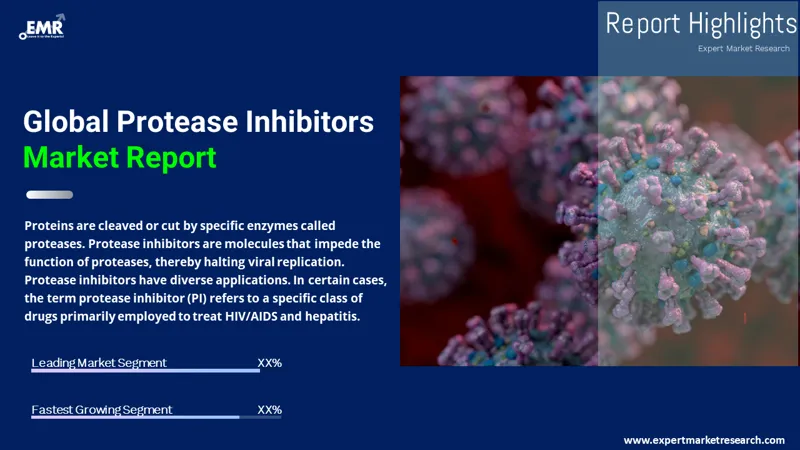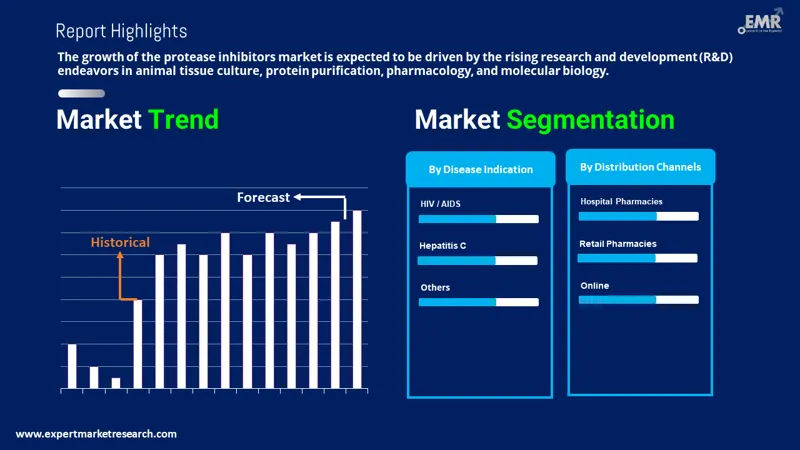
Consumer Insights
Uncover trends and behaviors shaping consumer choices today
Procurement Insights
Optimize your sourcing strategy with key market data
Industry Stats
Stay ahead with the latest trends and market analysis.
The global protease inhibitors market was valued at USD 5.62 Billion in 2025, driven by the rising prevalence of chronic diseases across the globe. The market is expected to grow at a CAGR of 4.40% during the forecast period of 2026-2035, with the values likely to reach USD 8.64 Billion by 2035.
Base Year
Historical Period
Forecast Period
Advances in drug delivery technologies are enhancing the efficacy and convenience of protease inhibitors, thus increasing their adoption in the market.
Greater awareness and improved diagnostic techniques for diseases treated with protease inhibitors are contributing to market expansion.
One of the major market trends includes collaborations between pharmaceutical companies and research institutions, accelerating the development and commercialization of new protease inhibitors.
Compound Annual Growth Rate
4.4%
Value in USD Billion
2026-2035
*this image is indicative*
Protease inhibitors are a class of medications that block the activity of proteases, which are enzymes that break down proteins. By inhibiting these enzymes, protease inhibitors prevent the cleavage of protein substrates necessary for the replication and function of certain viruses and the progression of some diseases. These inhibitors are commonly used in the treatment of viral infections such as HIV/AIDS and hepatitis C, as well as in some cancer therapies, where they help to prevent the maturation and spread of disease-causing agents.
The application of protease inhibitors is expanding due to higher healthcare spending globally, enabling better access to advanced treatments and ongoing R&D activities by pharmaceutical companies to develop new protease inhibitors with fewer side effects are driving market growth. The expiration of patents for major protease inhibitors is allowing the entry of generic versions, making these treatments more accessible and affordable globally.

Read more about this report - REQUEST FREE SAMPLE COPY IN PDF
Advancements in Biotechnology Augmenting the Market Growth
Advancements in biotechnology have led to the development of more effective and specific protease inhibitors. This driver is supported by continuous innovations in molecular biology, computational chemistry, and drug delivery systems, which enhance the efficacy and safety of these drugs. For Instance, in February 2024, KalVista Pharmaceuticals, Inc., a clinical-stage pharmaceutical company specializing in the discovery, development, and commercialization of small molecule protease inhibitors, announced positive results from the phase 3 KONFIDENT clinical trial. The trial demonstrated that sebetralstat, an oral on-demand therapy for hereditary angioedema (HAE), showed statistically and clinically significant efficacy. This novel molecule can help patients with HAE globally resulting in better market positioning of the company.
Strategic Collaborations and Partnerships to Meet Rising Protease Inhibitors Market Demand
Collaborations and partnerships between pharmaceutical companies and research institutions are accelerating the development and commercialization of new protease inhibitors. These strategic alliances combine resources and expertise, leading to innovative solutions and faster market entry. For Instance, AbbVie, a global biopharmaceutical company, and Principia Biopharma Inc., a private clinical-stage biopharmaceutical company, announced today a collaboration to develop oral immunoproteasome inhibitors. This partnership aims to create first-in-class oral therapies that harness the power of proteasome inhibition for safe application in the field of immunology. This collaboration contemplated the creation and development of orally bioavailable, selective inhibitors of the immunoproteasome subunits to target autoimmunity.
The market is witnessing several trends and developments to improve the current global scenario. Some of the notable trends are as follows:
“Protease Inhibitors Market Report and Forecast 2026-2035” offers a detailed analysis of the market based on the following segments:
Market Breakup by Disease Indication
Market Breakup by Distribution Channels
Market Breakup by Region

Read more about this report - REQUEST FREE SAMPLE COPY IN PDF
Market Segmentation Based on Disease Indication is Anticipated to Witness Substantial Growth
By disease indication, the market is segmented into HIV/ AIDS, Hepatitis C, Alpha-1 Antitrypsin Deficiency, Hereditary Angioedema (HAE) and others. Developing healthcare infrastructure and growing demand for advanced treatments in emerging markets are significant growth drivers. The rising occurrence of lifestyle-related diseases that may require protease inhibitors for treatment is boosting the market. Also, progress in molecular biology and computational chemistry is leading to the discovery of novel protease inhibitors, expanding their therapeutic applications.
Based on the region, the market report covers North America, Europe, Asia Pacific, Latin America, and the Middle East and Africa. North America is dominating the market share due to the high economic burden of managing chronic diseases motivating the adoption of effective treatments like protease inhibitors to improve patient outcomes and reduce healthcare costs.
Europe also holds a high protease inhibitors market value driven by the improvements in healthcare infrastructure in emerging markets increasing the availability and adoption of protease inhibitors. Additionally, Asia Pacific is expected to witness substantial market growth fueled by the growing patient pool and the increasing recognition of protease inhibitor benefits. An aging population is more susceptible to chronic diseases, thereby increasing the demand for protease inhibitors for appropriate and effective treatment and management.
The comprehensive EMR report provides an in-depth assessment of the market based on the Porter's five forces model along with giving a SWOT analysis. The report gives a detailed analysis of the following key players in the Protease Inhibitors Market, covering their competitive landscape and latest developments like mergers, acquisitions, investments, and expansion plans.
Boehringer Ingelheim International GmbH, a German-based pharmaceutical business creates, produces, and sells medicines, parasiticides, vaccines, and treatments for unmet medical needs. It provides a wide range of products, including biopharmaceuticals, animal health care items, and treatments for human ailments. The company's goods are used, among other things, to treat diseases of the immune system, central neurological system, cardiometabolic system, respiratory system, retina, and various cancers.
Bristol-Myers Squibb Company, a speciality biopharmaceutical company founded in 1887 with its headquarters in the United States, specialises in the discovery, development, licencing, manufacturing, marketing, distribution, and sale of medications and other healthcare products to patients with serious diseases. Its main areas of focus are cardiovascular, cancer, immunology, and fibrotic therapeutic projects. The business provides its goods to wholesalers, retail pharmacies, hospitals, healthcare workers, and governmental organisations all around the world.
*Please note that this is only a partial list; the complete list of key players is available in the full report. Additionally, the list of key players can be customized to better suit your needs.*
Other key players in the market include Johnson & Johnson Services, Inc., KalVista Pharmaceuticals, Inc., Cocrystal Pharma, Inc., Pfizer Inc., and Protinhi Therapeutics among others.




*While we strive to always give you current and accurate information, the numbers depicted on the website are indicative and may differ from the actual numbers in the main report. At Expert Market Research, we aim to bring you the latest insights and trends in the market. Using our analyses and forecasts, stakeholders can understand the market dynamics, navigate challenges, and capitalize on opportunities to make data-driven strategic decisions.*
Get in touch with us for a customized solution tailored to your unique requirements and save upto 35%!
Explore our key highlights of the report and gain a concise overview of key findings, trends, and actionable insights that will empower your strategic decisions.
| REPORT FEATURES | DETAILS |
| Base Year | 2025 |
| Historical Period | 2019-2025 |
| Forecast Period | 2026-2035 |
| Scope of the Report |
Historical and Forecast Trends, Industry Drivers and Constraints, Historical and Forecast Market Analysis by Segment:
|
| Breakup by Disease Indication |
|
| Breakup by Distribution Channels |
|
| Breakup by Region |
|
| Market Dynamics |
|
| Supplier Landscape |
|
| Companies Covered |
|
Single User License
One User
USD 5,499
USD 4,949
tax inclusive*
Datasheet
One User
USD 3,299
USD 2,969
tax inclusive*
Five User License
Five User
USD 6,999
USD 5,949
tax inclusive*
Corporate License
Unlimited Users
USD 8,199
USD 6,969
tax inclusive*
*Please note that the prices mentioned below are starting prices for each bundle type. Kindly contact our team for further details.*
Flash Bundle
Small Business Bundle
Growth Bundle
Enterprise Bundle
*Please note that the prices mentioned below are starting prices for each bundle type. Kindly contact our team for further details.*
Flash Bundle
Number of Reports: 3
20%
tax inclusive*
Small Business Bundle
Number of Reports: 5
25%
tax inclusive*
Growth Bundle
Number of Reports: 8
30%
tax inclusive*
Enterprise Bundle
Number of Reports: 10
35%
tax inclusive*
How To Order

Select License Type
Choose the right license for your needs and access rights.

Click on ‘Buy Now’
Add the report to your cart with one click and proceed to register.

Select Mode of Payment
Choose a payment option for a secure checkout. You will be redirected accordingly.
Gain insights to stay ahead and seize opportunities.

Get insights & trends for a competitive edge.

Track prices with detailed trend reports.

Analyse trade data for supply chain insights.

Leverage cost reports for smart savings

Enhance supply chain with partnerships.

Connect For More Information
Our expert team of analysts will offer full support and resolve any queries regarding the report, before and after the purchase.
Our expert team of analysts will offer full support and resolve any queries regarding the report, before and after the purchase.
We employ meticulous research methods, blending advanced analytics and expert insights to deliver accurate, actionable industry intelligence, staying ahead of competitors.
Our skilled analysts offer unparalleled competitive advantage with detailed insights on current and emerging markets, ensuring your strategic edge.
We offer an in-depth yet simplified presentation of industry insights and analysis to meet your specific requirements effectively.
Share